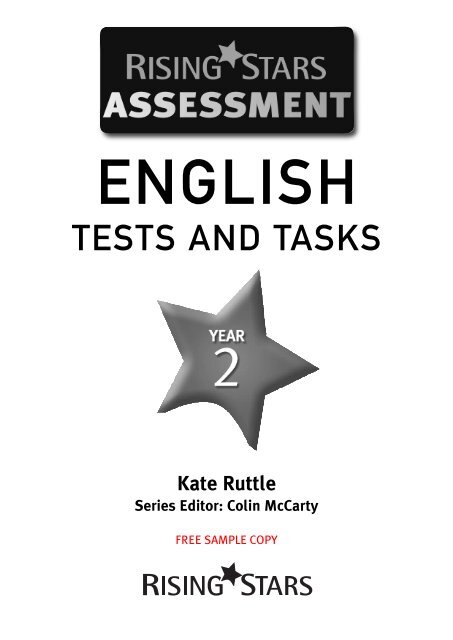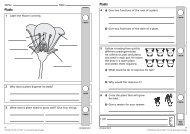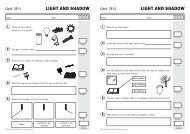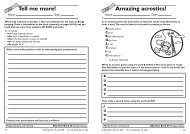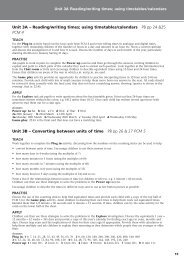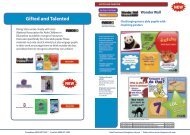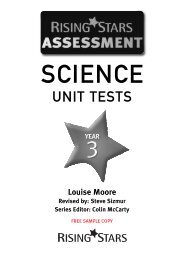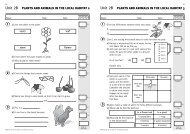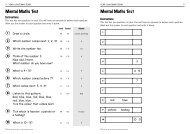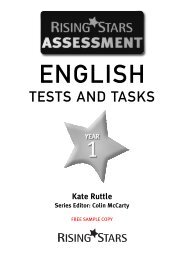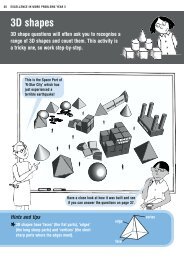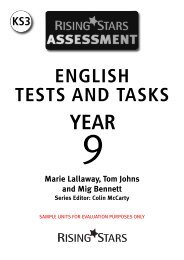TESTS AND TASKS - Rising Stars
TESTS AND TASKS - Rising Stars
TESTS AND TASKS - Rising Stars
- No tags were found...
Create successful ePaper yourself
Turn your PDF publications into a flip-book with our unique Google optimized e-Paper software.
ENGLISH<strong>TESTS</strong> <strong>AND</strong> <strong>TASKS</strong>Kate RuttleSeries Editor: Colin McCartyFREE SAMPLE COPY
Quick start guide to <strong>Rising</strong> <strong>Stars</strong> AssessmentStep 1 Introduce the testsThe tests are linked to the range of genres and text types recommendedby the Primary Framework for literacy and mathematics. Explain to theclass that they will take one reading test and two writing tasks eachhalf-term. This will give them the opportunity to show what they knowand can do. The tests are designed to give them the opportunity to showtheir reading and writing fiction and non-fiction and results can be usedto record and monitor progress throughout the year.At the end of each half-term, photocopy the test and give it to the classto complete.With younger age groups, you may also project the test onto awhiteboard to support the whole class or a group in the reading tests orwriting tasks.Step 2 Mark the testTests and tasks can be marked by the teacher, or by the pupil. Pupilsmay assess their own work or swap tests and mark another pupil’s test.Use the mark scheme and your own professional judgement to awardmarks. Do not award half marks.We suggest you annotate the mark grid for the writing task with a tickto indicate the bullet points for which you are awarding credit. Circle orwrite the mark you are giving.The mark schemes for reading include information about the level ofeach question and the assessment focus (AF) that is targeted throughindividual questions.Reading Test 1: Planet NarlName: Class: Date: ☺☹Sam got off the spaceship.He was on Planet Narl.To his left he could see a big city and to his right he couldsee jungle.Sam loved jungles because they had suchgood animals and plants in them.The jungle on Planet Narl might havesome new animals and plants in it.Sam smiled.©123Which planet is Sam on?Sam got to the planet on a:spaceshipcara) Did Sam want to go to the city or to the jungle?b) Why?<strong>Rising</strong> <strong>Stars</strong> UK Ltd 2008. You may photocopy this page.busbikeMark schemes for reading testsReading Test 1: Planet NarlFramework: Y2 Narrative Unit 4 Stories and fantasy worlds AF Mk Lvl Extra information1. Planet Narl 2 1 12. ✓ spaceship 2 1 13. a) jungle3 1 2b) he loved jungles2 1 3 b) accept ‘for adventure’4. any two from: stung, bit, slapped, whacked, gave him spots 2 2 2 1 mark for each correct answer5. when the spots went away 3 1 36. any one from: to keep him safe in the jungle; to warn him of the dangers of 3 1 3 accept ‘he was bored; so he knew morethe jungleabout the jungle; because the junglewas dangerous; because she wasworried about him’7. ✓ because it was dangerous 2 1 28. she was worried he might get hurt 3 1 3 accept ‘it’s too dangerous’9. yes – he said “Wow!”; he asked if they could go and see it 3 1 210. ✓ a made-up story 4 1 211. accept any appropriate title 6 1 212. no – because it’s too dangerous6 1 3 there is no mark for the first part of theyes – because I want to see the caterpillarquestion; award the mark for anyreasoned response and explanation13. any one from: Sam and Zad will go into the jungle to find the caterpillar; 3 1 2 accept an answer that recognises theSam and Zad plan to go into the jungle to find the caterpillar but Sam’s muminevitability of the adventure or Sam’sfinds out and they get into troublemother finds out their plan and Sam isin serious troubleReading Test 2: Holiday PostcardsFramework: Y2 Narrative Unit 1 Stories with familiar settings AF Mk Lvl Extra information1. ✓ swimming 2 1 12. a swimming ring 2 1 23. a) Becky’s brother3 1 2 a) accept ‘friend’b) two or nearly three2 1 24. in a caravan or on a farm or in the country 3 1 2 accept either answer for the mark5. ✓ in the country 3 1 26. chickens 2 1 27. Friday 2 1 28. ✓ sad films 3 1 29. it is too cold and wet 2 1 210. flapping the fish or playing the game 3 1 311. yes – she says it was good fun 2 1 3 the mark is for the explanation only12. (their) Gran 2 1 2 accept ‘Gran’ or ‘gran’13. accept any reasonable explanation 6 1 314. Tim – started learning to swim3 1 2 all three matched correctly for 1 markBecky – swam a lotBen – went to the country9AF21 markAF21 markAF31 markAF21 markTotal forthis page123a3b39Step 3 Generate a levelUse the mark and level threshold tables to convert the pupil’s mark to asub-level. The final row in each table gives an overall sub-level for eachterm’s tests. If you have the CD-ROM version of English Tests and Tasksyou can use the interactive Level Calculator to convert marks to levelsautomatically.The mark and level threshold pages also include a summary of thedistribution of marks and levels for each test.Step 4 Feed back to the pupilsThe marks and level thresholds for Year 2Levels are given for individual reading tests and pairs of reading tests for each term.Levels are also given for short and long writing tasks. A combined writing level from a short writingtask and a long writing task is also given. In this way, reading and writing may be monitoredindividually.For schools following a half-termly assessment policy in English, we provide a combined levelcomprising each half term’s reading piece with its accompanying short and long writing task. Spellingand handwriting are also included in the calculation of the level.Balance of marks and levels in each reading test:NC level Test 1 Test 2 Test 3 Test 4 Test 5 Test 61 2 1 1 1 12 8 11 5 9 6 73 5 3 9 6 2 7Mark ranges for sub-levels for Reading Test 1: Planet Narl1c 1b 1a 2c 2b 2a 3c 3b 3a2–3 4–5 6–7 8–9 10–11 12–13 14 15 N/AMark ranges for sub-levels for Reading Test 2: Holiday Postcards1c 1b 1a 2c 2b 2a 3c 3b 3a1–2 3–4 5–6 7–8 9–10 11–12 13–14 15 N/AAutumn term reading level1c 1b 1a 2c 2b 2a 3c 3b 3a3–6 7–10 11–14 15–18 19–22 23–26 27–29 30 N/AMark ranges for sub-levels for Reading Test 3: The Stork and the Fox1c 1b 1a 2c 2b 2a 3c 3b 3a5 6 7 8 9–10 11 12 13–14 15Mark ranges for sub-levels for Reading Test 4: Elephants1c 1b 1a 2c 2b 2a 3c 3b 3a4 5–6 7 8 9 10–11 12 13–14 15Spring term reading level1c 1b 1a 2c 2b 2a 3c 3b 3a9–10 11–13 14–16 17–18 19–20 21–23 24–25 26–29 30Mark ranges for sub-levels for Reading Test 5: The Polar Bears Gryff1c 1b 1a 2c 2b 2a 3c 3b 3a4 5–6 7 8 9 10–11 12 13–14 15Mark ranges for sub-levels for Reading Test 6: Creatures of the Arctic1c 1b 1a 2c 2b 2a 3c 3b 3a5 6 7 8 9–10 11 12 13–14 15Use a five-minute session with pupils to talk through the test and giveSummer term reading level2c 2b 2a 1c 1b 1a 3c 3b 3aN/A 1–5 6–8 9–11 12–16 17–19 20–22 23–27 28–30them the opportunity to make their own corrections. Identify strengths56and weaknesses and agree targets for learning.Encourage pupils to complete the diagnostic profile for reading and self-assessment sheets for writingafter each test or task. Pupils can keep these sheets and use them to record their progress throughoutthe year.
IntroductionEnglish Tests and Tasks has been produced to help teachers provide effective assessment for learningin English and to deliver formative assessment of progress across Key Stages 1 and 2. The assessmentmaterials have been:• designed by an assessment expert;• written by experienced classroom teachers;• reviewed by an educational consultant for English;• reviewed by a language expert to ensure accessibility of language and content;• trialled with schools;• equated and standardised by an assessment expert to ensure reliability of the levels.The tests are easy to use and mark. The scores for each test and task have been converted to sublevels.The level and sub-level information can then be used to investigate, monitor and report on theperformance of each pupil by:• plotting each pupil’s progress from term to term (summative assessment);• diagnosing each pupil’s strengths and weaknesses against the assessment focuses for readingand writing (diagnostic assessment);• enabling each pupil to review his or her own progress in a structured manner;• informing your own assessment for learning strategy and supporting your lesson planning(formative assessment).Combined, the results from the tests can be used to gather reliable evidence to assist target settingand predicting a pupil’s future performance.The table below summarises the range of National Curriculum levels covered in the tests and tasks foreach year. Further detail is provided in the mark schemes and the mark and level threshold section.Year 1 Year 2 Year 3 Year 4 Year 5 Year 6Level P8–2c Level 1c–3a Level 1a–4b Level 2c–4a Level 2b–5c Level 3c–6cAbout the English Tests and TasksThe tests are linked to the range of genres and text types recommended by the Primary framework forliteracy and mathematics (October 2006). Details of the block and unit to which each test and task islinked are given in the mark schemes. For ease of use, the tests in this book are presented as a seriesof assessments for use in the autumn, spring and summer terms respectively. There are two sets oftests for each term. You may use them in different terms if you wish; they are not prescriptive. Eachset of tests comprises:• a reading test that measures performance against a range of the reading assessment focuses(AFs);• a short writing task and a long writing task.We believe it helps for the writing tasks to follow the reading test as this gives background andpointers to assist pupils in their own writing.If your school’s assessment policy values a termly or bi-annual summative test, English Tests and Taskscan be used to obtain a National Test-equivalent mark from any of the three sets of tests. To do this,give pupils the following tests from any term:• a fiction reading test;• a non-fiction reading test;• a short writing task;• a long writing task.
YEAR 2/INTRODUCTIONThe combined results of such a test, together with a spelling and handwriting mark, will give you anaccurate and reliable indicator of the level at which each pupil is working.Furthermore, the reading tests and writing tasks will provide you with diagnostic informationthroughout the year which will show the progress the pupils are making in each reading and writingassessment focus. This will enable you to set and monitor each pupil’s targets for improvement.If your school’s assessment policy is to test towards the end of the academic year, it is recommendedthat you select the following tests from the summer term section of the book:• a fiction reading test;• a non-fiction reading test;• a short writing task;• a long writing task.Every effort has been made to ensure that the levels and sub-levels reported are accurate and reliable,but a test is only a snapshot of a pupil’s performance and may vary quite significantly depending on awide variety of circumstances, interest and prior experience. Each sub-level obtained from one testcovers a small number of marks, so a change of one mark can affect a pupil’s sub-level.The reading testsThe reading tests are worth 15 marks each. In the reading tests, the questions assess across the rangeof assessment focuses for reading, at a level which is appropriate for the target age group. Details ofthe AFs for reading are included in the mark scheme.Reading assessment focuses coveredAF2: understand, describe, select or retrieve information, events or ideas from texts and use quotationand reference to text;AF3: deduce, infer or interpret information, events or ideas from texts;AF4: identify and comment on the structure and organisation of texts, including grammatical andpresentational features at text level;AF5: explain and comment on writers’ uses of language, including grammatical and literary featuresat word and sentence level;AF6: identify and comment on writers’ purposes and viewpoints and the overall effect of the text onthe reader.The writing tasksThe short writing task is marked out of 13 and the long writing task is marked out of 22. In thewriting tasks, the challenges are chosen to be suitable for the age and experience of the pupil. Thewriting tasks should enable pupils to demonstrate what they have learned against the criteria of thewriting assessment focuses, thus enabling them to achieve appropriate levels in the tests. The writingtasks also provide opportunities to assess both spelling and handwriting.Writing assessment focuses coveredAF1: write imaginative, interesting and thoughtful texts;AF2: produce texts which are appropriate to task, reader and purpose;AF3: organise and present whole texts effectively, sequencing and structuring information, ideas andevents;AF4: construct paragraphs and use cohesion with and between paragraphs;AF5: vary sentences for clarity, purpose and effect;AF6: write with technical accuracy of syntax and punctuation in phrases, clauses and sentences;AF7: select appropriate and effective vocabulary;AF8: use correct spelling.
YEAR 2/INTRODUCTIONHow to use English Tests and Tasks in your schoolPreparation and timings1 Copy the required number of sheets to form the chosen assessment.2 Ensure pupils are seated appropriately to prevent overlooking each other’s papers.3 Pupils will need pens or pencils and erasers. Pupils should be encouraged to cross out answersrather than rubbing them out.4 The suggested time limits are:• 1 hour and 15 minutes (including 15 minutes reading time) for the reading test. Help withreading may be given using the same rules as when providing a reader with QCA Optional orKey Stage tests. Allow up to 25% extra time allowance for poor readers.• Allow no more than 45 minutes for the longer writing task and no more than 30 minutes forthe shorter writing task.5 The writing tasks should be read to pupils before they start to write their answers.Supporting pupils during the testsBefore the test, explain to pupils that the test is an opportunity to show their progress in reading andwriting fiction and non-fiction.Many pupils will be able to work independently in the tests, with minimal support from the personadministering the tests. This person may encourage the student to ‘have a go’ at a question, or tomove on to a fresh question if they appear to be stuck, ensuring that no pupil becomes distressed.It is important that pupils receive appropriate support, but are not unfairly advantaged ordisadvantaged. Throughout the tests, therefore, the teacher may read, explain or sign to a pupil anyparts of the test that include instructions, for example by demonstrating how to circle an answer.With younger age groups you may also consider projecting the test or task onto a whiteboard tosupport a whole class or group. You may choose to refer to the words on the whiteboard and readthem aloud so that pupils can follow them and write their answers on their papers individually.Marking the testMark schemes for reading testsA variety of strategies is possible, including peer- and self-assessmentReading Test 1: Planet NarlFramework: Y2 Narrative Unit 4 Stories and fantasy worlds AF Mk Lvl Extra information1. Planet Narl 2 1 1as well as marking by the teacher. Use the detailed mark scheme and✓ 2. spaceship 2 1 13. jungle3 1 2a)b) he loved jungles2 1 3 b) accept ‘for adventure’4. any two from: stung, bit, slapped, whacked, gave him spots 2 2 2 1 mark for each correct answeryour professional judgement to award marks. Do not award half marks.5. when the spots went away 3 1 36. any one from: to keep him safe in the jungle; to warn him of the dangers of 3 1 3 accept ‘he was bored; so he knew morethe jungleabout the jungle; because the junglewas dangerous; because she wasWe suggest that you annotate the mark grid for the writing task with aworried about him’✓ 7. because it was dangerous 2 1 28. she was worried he might get 3 1 3 hurt accept ‘it’s too dangerous’9. yes – he said “Wow!”; he asked if they could go and see it 3 1 2tick to indicate the bullet points for which you are awarding credit. In✓ 10. a made-up story 4 1 211. accept any appropriate 6 1 2titleaddition, circle or write the mark you are giving.12. no – because it’s too dangerous6 1 3 there is no mark for the first part of theyes – because I want to see the caterpillarquestion; award the mark for anyreasoned response and explanation13. any one from: Sam and Zad will go into the jungle to find the caterpillar; 3 1 2 accept an answer that recognises theSam and Zad plan to go into the jungle to find the caterpillar but Sam’s muminevitability of the adventure or Sam’sfinds out and they get into troublemother finds out their plan and Sam isin serious troubleThe mark grids for the writing tasks indicate the typical performance aReading Test 2: Holiday PostcardsFramework: Y2 Narrative Unit 1 Stories with familiar settings AF Mk Lvl Extra information1. ✓ swimming 2 1 1pupil working at a specific sub-level is likely to show in their writing.2. swimming ring 2 1 2a3. a) Becky’s brother3 1 2 a) accept ‘friend’b) two or nearly three2 1 24. in a caravan or on a farm or in the country 3 1 2 accept either answer for the mark5. ✓ in the country 3 1 2It is suggested that marked tests be returned to pupils so that they can6. chickens 2 1 27. Friday 2 1 28. ✓ sad films 3 1 2transfer the scores to their progress record sheets (see page 8). In this9. it is too cold and wet 2 1 210. flapping the fish or playing the game 3 1 311. yes – she says it was good fun 2 1 3 the mark is for the explanation only12. (their) Gran 2 1 2 accept ‘Gran’ or ‘gran’way they will become more aware of their own strengths and13. accept any reasonable explanation 6 1 314. Tim – started learning to swim3 1 2 all three matched correctly for 1 markBecky – swam a lotBen – went to the countryweaknesses. Pupils should be encouraged to make their own corrections39when they are undertaking the analysis of their performance.Use a five-minute feedback session with a pupil as they transfer their test outcomes to the readingdiagnostic profiles and writing self-assessment sheets. This provides a useful opportunity to discuss anindividual’s progress and to explore any areas of uncertainty.
YEAR 2/INTRODUCTIONObtaining levels and sub-levelsThe tables on pages 56-58 give the mark ranges for each sub-level foreach test. The CD-ROM version of English Tests and Tasks allows you toenter the raw score gained for each test, plus spelling and handwriting,by each pupil. The sub-levels and overall levels for a set of tests arecomputed and displayed. This data may then progress through theschool with the pupil allowing you to keep an electronic mark book forhis/her primary experience.The marks and level thresholds for Year 2Levels are given for individual reading tests and pairs of reading tests for each term.Levels are also given for short and long writing tasks. A combined writing level from a short writingtask and a long writing task is also given. In this way, reading and writing may be monitoredindividually.For schools following a half-termly assessment policy in English, we provide a combined levelcomprising each half term’s reading piece with its accompanying short and long writing task. Spellingand handwriting are also included in the calculation of the level.Balance of marks and levels in each reading test:NC level Test 1 Test 2 Test 3 Test 4 Test 5 Test 61 2 1 1 1 12 8 11 5 9 6 73 5 3 9 6 2 7Mark ranges for sub-levels for Reading Test 1: Planet Narl1a 2c 2b 2a 3c 1c 1b 3b 3a2–3 4–5 6–7 8–9 10–11 12–13 14 15 N/AMark ranges for sub-levels for Reading Test 2: Holiday Postcards1a 2c 2b 2a 3c 1c 1b 3b 3a1–2 3–4 5–6 7–8 9–10 11–12 13–14 15 N/AAutumn term reading level2c 2b 2a 1c 1b 1a 3c 3b 3a3–6 7–10 11–14 15–18 19–22 23–26 27–29 30 N/AMark ranges for sub-levels for Reading Test 3: The Stork and the Fox1a 2c 2b 2a 3c 1c 1b 3b 3a5 6 7 8 9–10 11 12 13–14 15Mark ranges for sub-levels for Reading Test 4: Elephants1a 2c 2b 2a 3c 1c 1b 3b 3a4 5–6 7 8 9 10–11 12 13–14 15Spring term reading level2c 2b 2a 1c 1b 1a 3c 3b 3a9–10 11–13 14–16 17–18 19–20 21–23 24–25 26–29 30Mark ranges for sub-levels for Reading Test 5: The Polar Bears Gryff1a 2c 2b 2a 3c 1c 1b 3b 3a4 5–6 7 8 9 10–11 12 13–14 15Mark ranges for sub-levels for Reading Test 6: Creatures of the Arctic1a 2c 2b 2a 3c 1c 1b 3b 3a5 6 7 8 9–10 11 12 13–14 15Summer term reading level2c 2b 2a 1c 1b 1a 3c 3b 3aN/A 1–5 6–8 9–11 12–16 17–19 20–22 23–27 28–3056Pupil progress recordsBuilding-up the whole year diagnostic profile for readingAll the reading tests have been analysed against the assessment focuses for reading. The pattern ofmarks covering the assessment focuses for each test is supplied as a diagnostic profile bar chart.Pupils should shade in the bar chart with their scores in each reading assessment focus for eachreading test, so that they can see their strengths and weaknesses at a glance. The six diagnosticprofiles covering a term’s tests are on one page for ease of use. This series of profiles enables pupils tobuild a dynamic picture of their strengths and weaknesses in reading. They can also be used toidentify where pupils need to do further work.Reading Test 1: Planet NarlAF my scores totals2636415062701Date:2 3 4 5 6 7 8 9 10 11 12Completing the progress record sheets for writingThe self-assessment sheets, which are on the CD-ROMversion of English Test and Tasks, have been designed toenable pupils to analyse their performance in writing. Pupilswill be able to identify strengths and weaknesses and settheir targets for future learning. Teachers have also indicatedthat this process is extremely useful to establish a sharedvocabulary of assessment, which helps inform the next stepsin teaching and learning.Pupil record sheet for writing (levels 2a and 3c)Name:Class:• Every time I reach a target, I can put a tick in a box beside it. • When I have three ticks, I have achieved the target. • When I achieve a target, I can colour in a box in the chart below.Level Punctuation, spelling and handwriting Writing stories Writing non-fictionOver half of my sentences have properI always write in the past tense.I know how to write:punctuation. I can use: capital letters, full• instructionsstops, question marks and exclamationmarks.I can use these connectives: because, when,so in my writing.• reports• recountsI write stories with a beginning, a middle• explanations.3cI use commas in lists.I spell more than half of my words correctly.I can spell all of the words on list 1 in myand an end.I can show some paragraphs.I can use headings and subheadings.I can show some paragraphs.writing.I use interesting adjectives in my writing.In my writing, I join some letters.I am good at:date:I need to improve:date:Level Punctuation, spelling and handwriting Writing stories Writing non-fictionNearly half of my sentences have full stopsI usually write in the past tense.I know how to write:and capital letters.• instructionsI can join sentences using words like: and,• reportsI spell short words correctly. I can spell 15 ofbut, then, when.• recountsthe words on list 1 and all of the words in• explanations.2alist 2 in my writing.My stories show the order in which thingshappen.I can put in details to interest my reader.In my writing, my letters look right and Iknow how to join some of them.I put in some details about my character and I choose words carefully when I want tosetting.describe something.I am good at:date:I need to improve:date:
Reading Test 2: Holiday PostcardsName: Class: Date: ☺☹Dear Gran,We are having a good holiday. It isvery sunny. I like swimming in thepool. I can swim by myself now so Iswim all the time. I don’t need theswimming ring any more. I gaveit to Tim so he can learn to swimas he is big enough now. Hewill be three soon.Lots of love fromBecky1Becky likes:AF21standingswimming1 marksittingsmiling2What did Becky give Tim?AF221 mark3a) Who do you think Tim is?AF33a1 markAF2b) How old is Tim?1 mark3b<strong>Rising</strong> <strong>Stars</strong> UK Ltd 2008. You may photocopy this page.©Total forthis page
Reading Test 2: Holiday PostcardsDear Gran,Thank you for letting us have your holiday caravan. It isnot very big but it is fun and we are having a good time.Today the farmer let us feed the chickens. We lookedat all the animals. I think the horses are a bit scarybecause they are so big but I liked the sheep best. Iput my hand on one. Its wool is different from the woolyou use to make my jumpers.We will be back onFriday. Mum says willyou come for dinneron Sunday?Love fromBen4Where is Ben staying on his holiday?AF341 mark5Where was Ben’s gran’s caravan?AF35by the beachby a pool1 mark6in the countryWhich animals did Ben feed?at the seaside1 markAF27 When will Ben be home?1 mark© <strong>Rising</strong> <strong>Stars</strong> UK Ltd 2008. You may photocopy this page.AF2Total forthis page67
Reading Test 2: Holiday PostcardsDear Gran,Today, it is raining. It has rained all the time since we gothere. We have watched lots of films. I like cartoons best butMum likes films that make her cry. I don't understand that!We can’t go to the beach because it is too cold and wet, butwe are still having fun because we make up games. Dad makesup the best games. Yesterday, we all had to make fish out ofpaper and flap them all over the house. After the game wewent out for ice-cream because we were all so hot. Today weplayed a game called ‘Jumping Fish’. It was a very silly gamebut it was good fun.I hope you are having a goodholiday too.Love you lotsBina8What kind of films does Mum like?AF38scary filmssad films1 markfunny filmscartoon films9Why can’t they go to the beach?AF291 mark10What made them all feel hot?AF3101 mark11Did Bina like playing ‘Jumping Fish’?AF211How do you know?1 mark<strong>Rising</strong> <strong>Stars</strong> UK Ltd 2008. You may photocopy this page.©Total forthis page
Reading Test 2: Holiday Postcards12These questions are about all of the postcards.Who did everyone write to?AF2121 mark13Who do you think had the best holiday?AF6131 markWhy?14Join up the person and what they did on holiday.One is done for you.AF31 mark14TimBeckyBenBinawent to the countrystarted learning to swimplayed gamesswam a lot/15<strong>Rising</strong> <strong>Stars</strong> UK Ltd 2008. You may photocopy this page.©Total forthis test
Short Writing Task 2How to Play a GameThink of a game you enjoy playing in PE or in the playground.Write instructions so that a new friend could play your game.In your instructions, remember to tell your new friend:• what the game is called;• what things you use to play the game;• how many people can play;• how you play the game;• the rules for your game.Try to think of everything yourfriend will need to know toplay your game.Long Writing Task 2My Favourite LessonThink of a lesson you enjoyed.What kind of lesson was it? PE, maths, science, art? Choose anylesson you like.• What happened in the lesson to make it so good?o Did you do something you really enjoyed doing?o Did someone say or do something funny?o Did the teacher do something to make the lessonreally good?• Who was there with you? Don’t name too many people – one ortwo good friends is enough.• How did you all feel in the lesson?Write an account telling someone about the lesson.<strong>Rising</strong> <strong>Stars</strong> UK Ltd 2008. You may photocopy this page.©
Mark schemes for reading testsReading Test 2: Holiday PostcardsFramework: Y2 Narrative Unit 1 Stories with familiar settings AF Mk Lvl Extra information1. ✓ swimming 2 1 12. a swimming ring 2 1 23. a) Becky’s brotherb) two or nearly three321122a) accept ‘friend’4. in a caravan or on a farm or in the country 3 1 2 accept either answer for the mark5. ✓ in the country 3 1 26. chickens 2 1 27. Friday 2 1 28. ✓ sad films 3 1 29. it is too cold and wet 2 1 210. flapping the fish or playing the game 3 1 311. yes – she says it was good fun 2 1 3 the mark is for the explanation only12. (their) Gran 2 1 2 accept ‘Gran’ or ‘gran’13. accept any reasonable explanation 6 1 314. Tim – started learning to swimBecky – swam a lotBen – went to the country3 1 2 all three matched correctly for 1 mark
Mark scheme for Short Writing Task 2: How to Play a Game Framework: Y2 Non-fiction Unit 1 InstructionsName: Class: Date:Spelling and handwritingComposition and effectSentence structure, punctuation and text organisationLevelSPELLINGUsing professional judgementMarksawarded% wordsspelledcorrectly• Instructional text is consistently used.• Features of information writing include:• an introductory sentence to explain the aim of the instructions. (It is funplaying ‘cats and mice’ in PE. This is how to play it.)• Headings are used to explain different functions of parts of the text (You willneed; What to do; Don't forget).6–7 marks• Sentences joined with connectives such as: because, when, so (When you areready you can begin; move quietly so they will not know where you are) on morethan one occasion.• Some appropriate use of adjectives (fast, still, hard, careful) and adverbs(slowly, carefully, gently).• Full stops and capital letters at least 50% accurate.6 marks3c15–10211–25• Features of information writing include:• all sentences begin with either adverb (First, Later, Lastly) or command(imperative) verb (Jump, Chase, Choose);• the instructions include some headings (You will need; What to do);• the sequence of events is clearly indicated by numbers, arrows or some otherdevice.• Some additional detail is given to help the reader to follow the instructions(Choose a leader who is wearing blue socks).• More than 30% of sentences end with full stops, question marks orexclamation marks and begin with capital letters.• Sentences joined with connectives such as: and, but, then, when (Hold out yourarms then wait for someone to run under them).<strong>Rising</strong> <strong>Stars</strong> UK Ltd 2008. You may photocopy this page.©326–40441–60561–752a676–90791–1005 marks5 marksH<strong>AND</strong>WRITINGAward 1 mark if:the handwriting is legible and shows somefeatures of regularity in size and spacing.However, the overall effect is disjointed anduneven.Award 2 marks if:overall, the handwriting is regular with someflow and movement. Letters and words areusually appropriate in size and position, butthere is some variation.• Features of instructional language include:• writing is in the present tense (Choose who is going to be it);• some use of adverbs (First, then, next) are used to indicate sequence ofevents.• The purpose of the text is to give instructions.• The vocabulary is appropriate and helps the reader to understand the ideas (e.g.using prepositions to describe where equipment should go under, on, beside, aswell as verbs of motion to describe how to move and where to go: jump intothe hoop).4 marks• Mainly simple sentences beginning with imperative or command verbs (choose;look).• Some sentences joined by connectives such as and, then (Choose a leader andthey choose their teams).• No more than three uses of and in any sentence.• 20%–30% of sentences marked by full stops and capital letters.2b4 marksAward 3 marks if:the handwriting is consistent and fluent withletters and words appropriately spaced. Thehandwriting may maintain a personal style.• Information is given which relates to playing a game, although the text typemay not be appropriate. (I ran to the goal and then I scored.)• The vocabulary used is appropriate and relevant. It may include nouns (ball,hoop, mat) and some use of verbs of motion (hop, run, jump).2–3 marks• At least two sentences have capital letters and full stops.• More than two pieces of information are given (e.g. two stages of playing thegame: (Run away as fast as you can, then stand still if it gets you).2c2–3 marks• Relevant topic is described, although not necessarily in the requested text type.(I played it and Shane was it.)• Writing is placed appropriately on the page.1 mark• Simple repetitive sentence structures (push the ball then run to it then get onit).• At least one full stop is used appropriately.• Writing can be read without mediation.• Some topic-related words are used (turn, run).1 mark1a
Mark scheme for Long Writing Task 2: My Favourite Lesson Framework: Y2 Narrative Unit 1 Stories with familiar settingsName: Class: Date:Reading resultsComposition and effectText structure and organisationSentence structure and punctuationLevelShow whether the questions werecorrect or incorrect.AF☹☺Q• An attempt is made to give the reader information s/heneeds to understand the context. (Our books are in ourdrawers.)• The people and setting are described using carefullychosenwords and phrases (She is so cool; it’s a bit messybut …).• The writer’s reactions are explained (I laughed andlaughed because it was so funny).• Some verbs are carefully chosen in order to help thereader to ‘see’ the action (she shrieked; he tiptoed).• Sentences joined with connectives such as: because,when, so (He wanted to cross because his best friend hadcrossed) on more than one occasion.• The recount has a clear beginning (In our numeracylesson on Tuesday), middle and end. (When it wasdinnertime, we had to stop playing. But it was the bestlesson ever.)• A variety of adjectives in simple noun phrases is used(The tiny globe; The new stepping stone mats).8–10 marks6 marks• Writing is consistently in the past tense.• Pronouns are sometimes used to avoid repetition ofnoun phrases. (Sharma wanted to go to the toilet but shecouldn’t tell the teacher.)• 50% of sentences end with full stops, question marks orexclamation marks and begin with capital letters.• Commas are generally used in lists, including lists ofevents. (She saw what was happening, but it was toolate.)• Adjectives are used effectively both before and afternouns (my favourite teacher; the maths teacher is myfavourite).6 marks3c<strong>Rising</strong> <strong>Stars</strong> UK Ltd 2008. You may photocopy this page.©223233223232263123a3b4567891011121314Total correct:• Aspects of recount writing include:• a clear sequence of events, which is memorable for agiven reason, is described to interest the reader;• some additional detail expands on what happened onat least one occasion. (His shirt came untucked and wecould see his tummy button.)• At least five words are carefully chosen to interest thereader.6–7 marks• Sentences joined with connectives such as: and, but,then, when• Simple adjectives are used in noun phrases (the redbucket).• Simple sentences (I found the number 5) and compoundsentences (joined with and, but, or, so) are used.• A simple sequence of events is described leading to aconclusion.5 marks• Writing is generally in the past tense, though this maynot be consistent. (I scored a goal. I run round and do ahandstand then I heard the whistle.)• More than 30% of sentences end with full stops,question marks or exclamation marks and begin withcapital letters.• Commas may be used in lists.2a5 marksLevel:Pattern of AF coverage in readingtest• Aspects of recount writing include:• some use of past tense – though this may not besustained;• a sequence of events that is indicated by adverbs(then, after that).• At least three words are carefully chosen to interest thereader (verbs like tried, missed; nouns like goal,parachute).4–5 marks• Ideas are grouped into sequences of sentences whichrelate to the same event or action. New events oractions are introduced with then, after that and so on.• A simple sequence of events is described, perhapswithout a clear conclusion.• Sentences joined by connectives such as and, then (Theteacher wanted to go out and ask the Head a question).• Mainly simple sentences beginning with person and verb(The teacher said; Nishal wanted to).• At least three sentences marked by full stops and capitalletters.• No more than three uses of and in any sentence.2b3–4 marks3–4 marks• There are aspects of recount in the writing:• the writing conveys a series of events;• first person (I, we) narrator.• The vocabulary used is appropriate and relevant(interactive whiteboard, guitar, tripped, fell, laughed).2–3 marks• The recount contains at least two different actions orevents. (I saw the puppets and I laughed then it was myturn to find something).• The lesson described has a memorable event.• At least two sentences have full stops and capitalletters.• Sentences are often speech-like. (It was funny and Ilaughed and Tina laughed.)2c3 marks2 marks1211109876543212 3 4 5 6Assessment focus• An attempt is made to describe a lesson.• Writing is placed appropriately on the page.• Writing can be read without needing mediation.• Attempts original writing, rather than retelling themodel text.1 mark1 mark• Simple sentence-like structures used. (We play footballand I played in goal and we won.)• At least one full stop is used appropriately.1 mark1a
Diagnostic profiles for readingName:The bar charts show the patterns of marks againstthe reading assessment focuses (AF).Shade in your scores to see your strengthsand where you need to do more work.Reading assessment focusesAFThis is what you have to do.2 find information or ideas3 understand and think about the information or ideas4 work out how sentences and texts are put together5 explain the writer’s choice of words and sentences6work out what the writer was trying to do and if itwas successful7 understand when or where a text was writtenReading Test 1: Planet NarlAF my scores totals263641506270Reading Test 2: Holiday PostcardsAF my scores totals28364050617011Date:2 3 4 5 6 7 8 9 10 11 12Date:2 3 4 5 6 7 8 9 10 11 12Reading Test 3: The Stork and the FoxAF my scores totals 12103540506070Date:2 3 4 5 6 7 8 9 10 11 12Reading Test 4: ElephantsAF my scores totals2833425062701Date:2 3 4 5 6 7 8 9 10 11 12Reading Test 5: The Polar Bears GryffAF my scores totals 1243340536273Reading Test 6: Creatures of the ArcticAF my scores totals 1273144516171Date:2 3 4 5 6 7 8 9 10 11 12Date:2 3 4 5 6 7 8 9 10 11 12<strong>Rising</strong> <strong>Stars</strong> UK Ltd 2008. You may photocopy this page.©
Pupil record sheet for writing (levels 3b and 3a)Name: Class:• Every time I reach a target, I can put a tick in a box beside it. • When I have three ticks, I have achieved the target. • When I achieve a target, I can colour in a box in the chart below.Level Punctuation, spelling and handwriting Writing stories Writing non-fiction3aMost of my sentences have properpunctuation at the end and begin with acapital letter.I sometimes use commas in complexsentences.I usually use speech marks when I punctuatedialogue.My handwriting is mostly joined.I can use a variety of tenses in my writing toshow what has happened, what is happeningand what might happen.I can use adverbial phrases to add moreinformation to my writing.I use a wide range of connectives.I describe characters’ reactions to events inmy stories.I always use paragraphs when I introduce anew topic.I know how to organise clauses in sentencesso that the most important idea ishighlighted.I use expanded noun phrases to give moreinformation.I can write a variety of persuasive texts.I am good at: date:I need to improve: date:Level Punctuation, spelling and handwriting Writing stories Writing non-fiction3bI use full stops and capital letters properly inmore than half of my sentences.I use commas in about half of the complexsentences I write.I know where to put speech marks when Iam writing dialogue.I use speech in my stories.I use the present tense for speech and Iremember to go back to the past tenseafterwards.I use time adverbials (like suddenly; just then,later on) to show the order of events.I can write introduction and conclusions inall text types.I can show my own viewpoint in non-fictiontexts.I make careful choices about the words thatI write.I can spell ten of the words in list 2 correctlyin my writing.I usually have five paragraphs when I write astory (beginning, problem, climax, resolution,ending).I use topic sentences to introduce thesubject of my paragraphs.I am good at: date:I need to improve: date:
The marks and level thresholds for Year 2Levels are given for individual reading tests and pairs of reading tests for each term.Levels are also given for short and long writing tasks. A combined writing level from a short writingtask and a long writing task is also given. In this way, reading and writing may be monitoredindividually.For schools following a half-termly assessment policy in English, we provide a combined levelcomprising each half term’s reading piece with its accompanying short and long writing task. Spellingand handwriting are also included in the calculation of the level.Balance of marks and levels in each reading test:NC level Test 1 Test 2 Test 3 Test 4 Test 5 Test 61 2 1 1 0 1 12 8 11 5 9 6 73 5 3 9 6 8 7Mark ranges for sub-levels for Reading Test 1: Planet Narl1c 1b 1a 2c 2b 2a 3c 3b 3a2–3 4–5 6–7 8–9 10–11 12–13 14 15 N/AMark ranges for sub-levels for Reading Test 2: Holiday Postcards1c 1b 1a 2c 2b 2a 3c 3b 3a1–2 3–4 5–6 7–8 9–10 11–12 13–14 15 N/AAutumn term reading level1c 1b 1a 2c 2b 2a 3c 3b 3a3–6 7–10 11–14 15–18 19–22 23–26 27–29 30 N/AMark ranges for sub-levels for Reading Test 3: The Stork and the Fox1c 1b 1a 2c 2b 2a 3c 3b 3a5 6 7 8 9–10 11 12 13–14 15Mark ranges for sub-levels for Reading Test 4: Elephants1c 1b 1a 2c 2b 2a 3c 3b 3a4 5–6 7 8 9 10–11 12 13–14 15Spring term reading level1c 1b 1a 2c 2b 2a 3c 3b 3a9–10 11–13 14–16 17–18 19–20 21–23 24–25 26–29 30Mark ranges for sub-levels for Reading Test 5: The Polar Bears Gryff1c 1b 1a 2c 2b 2a 3c 3b 3a4 5–6 7 8 9 10–11 12 13–14 15Mark ranges for sub-levels for Reading Test 6: Creatures of the Arctic1c 1b 1a 2c 2b 2a 3c 3b 3a5 6 7 8 9–10 11 12 13–14 15Summer term reading level1c 1b 1a 2c 2b 2a 3c 3b 3aN/A 1–5 6–8 9–11 12–16 17–19 20–22 23–27 28–30
Reliability and predictionsReading testsAll good reading tests should be a fair experience for each pupil; with some questions being easy,some quite challenging and some hard. This makes the reading assessment a valid experience,enabling the pupil to show progress in reading and writing, both fiction and non-fiction. The test mustalso cover what has been taught. The questions assess across the range of assessment focuses forreading, at a level which is appropriate for the target age group. In a properly designed and balancedtest, it is possible to work out a set of theoretical pass mark thresholds and these are discussed below.Theory and practice must come together, however, and the <strong>Rising</strong> <strong>Stars</strong> tests need to be standardisedand linked to the National Curriculum levels established by QCA in order for the levels to be reliableand valid. These equated sub-levels are given on pages 56–58.Writing tasksIn the writing tasks, the challenges are chosen to be suitable for the age and experience of the pupil.We believe it helps for the writing tasks to be taken after the reading test as this gives backgroundand pointers to assist pupils in their own writing. The writing tasks should enable pupils todemonstrate what they have learned against the criteria of the writing assessment focuses, thusenabling them to achieve appropriate levels in the tests. The writing tasks also provide opportunitiesto assess both spelling and handwriting and so mirror the optional tests from QCA. The levels reportedon pages 56–58 derive directly from the marking criteria in the mark schemes for the writing tasks.Standardising the tests<strong>Rising</strong> <strong>Stars</strong> conducted research with a sample of schools in April, May and June 2008. Pupils sat anumber of the reading tests, appropriate for each term of their year. The scores the pupils obtained onpairs of tests were used to generate an overall score out of 30 for that term. These scores were thenequated to results obtained from QCA tests for English. The details are as follows:• In Year 1, teacher assessment was the benchmark;• In Year 2, pupils’ scores were standardised by equating to their KS1 results for English;• In Years 3, 4 and 5, the standardisation was to the reading sub-levels obtained from theoptional reading test. This method was chosen to provide an externally validated test-basedcomparison for the levels;• In Year 6, pupils’ scores were standardised by equating to their KS2 English reading results.The table below summarises the number of schools and pupils that undertook to participate in theresearch.Year 1 2 3 4 5 6Number of pupils 291 310 359 368 395 350Number of schools 9 10 9 9 9 8Some of the schools were unable to complete the research or could only provide partial data.Consequently, the final sample was approximately half the original size for each year.Teachers and pupils in the schools also commented on the language, illustrations and suitability of thequestions in the tests. A number of the questions were refined and improved thanks to this advice.The equating data for the reading testsA series of equating exercises was undertaken to link the scores for the three pairs of tests to QCAlevels. This was done by an independent specialist using the same methodology used to equate
YEAR 2/RELIABILITY <strong>AND</strong> PREDICTIONSNational Curriculum tests from one year to the next in the development of QCA’s tests. A review ofthe performance of the pairs of tests for each term enabled levels to be determined for each individualtest. See the Appendix for further information.Development of tests – technical informationA level has been ascribed to every mark so that the tests can be seen from the outset to be balanced,covering an appropriate span of levels for the year group in question.The equating data was used to provide an empirical model that would enable theoretically-generatedsets of thresholds to be informed by the equated ones. We could then see how the tests compare interms of level of demand to the optional tests in particular. The algorithm <strong>Rising</strong> <strong>Stars</strong> evolved isshown below. The algorithm works on the basis of the understanding that pupils will do better oneasier questions and score less well on harder ones.• Questions at their working level – pupils get correct 40% of the marks available;• Questions at one level below their working level – pupils get correct 60% of the marksavailable;• Questions at two levels below their working level – pupils get all of the marks available;• Questions at one level above their working level – pupils are able to get correct 10% of themarks available;• Questions at two levels above their working level – are too hard for pupils and they get none ofthe marks available.Overall, we find that <strong>Rising</strong> <strong>Stars</strong> tests, by design, are quite challenging – sometimes more challengingthan QCA optional reading tests and multiple choice-based commercial reading tests, where pupilsgain more marks. However, the equating process makes sure that the sub-levels we report match tothe optional test levels for the end of the appropriate year. Feedback from our research schools andusers of <strong>Rising</strong> <strong>Stars</strong> tests over the past years indicates that challenging tests, requiring writtenanswers, taken throughout the year improve pupils’ performance more than challenges that are tooeasy. The result of this high-quality test practice is that pupils are better prepared when they takeexternally-set tests, be they optional or end of Key Stage national tests.A word of warningLevel threshold information is provided for each individual test, but it is recommended that at leasttwo tests be used to ensure there is sufficient coverage and balance for a valid and reliablesummative level for the term.AppendixThe standard score and percentile table overleaf shows the distribution of marks and provides relativeinformation about a pupil’s performance against his or her year group. Standard scores greater than115 are well above average; while those less than 85 are well below average.
YEAR 2/RELIABILITY <strong>AND</strong> PREDICTIONSStandard score 70 80 85 90 100 110 115 120 130Percentiles 2% 9% 16% 26% 50% 74% 84% 91% 98%RS Reading Tests 1and 2 score (outof 30 marks)RS Reading Tests 3and 4 score (outof 30 marks)RS Reading Tests 5and 6 score (outof 30 marks)3 10 16 20 24 26 27 28 2914 16 18 19 21 23 24 25 272 6 9 12 16 19 20 22 24Reading Tests 1 and 2 combinedThis pair of tests has a very strong correlation of pupils' levels with their test score givingPearson's r = 0.76. Correlation of pupils' levels with their age in months is fairly weak, however, givingPearson's r= 0.25. Overall this is a fairly easy and high-scoring pair of tests.Reading Tests 3 and 4 combinedThis pair of tests has a strong correlation of pupils' levels with their test score givingPearson's r= 0.63. Correlation of pupils' levels with their age in months is negative, givingPearson's r= -0.20. This pair of tests has a number of easy marks, but is strongly discriminating at theharder end.Reading Tests 5 and 6 combinedThis pair of tests has quite good correlation of pupils' levels with their test score givingPearson's r= 0.59. Correlation of pupils' levels with their age in months is weak, givingPearson's r= 0.18. This is quite a demanding pair of reading tests.The graphs below show the equating relationship for pairs of reading tests in each term betweenoverall marks and sub-levels. The closer pupils’ performance on the <strong>Rising</strong> <strong>Stars</strong> tests are to the KS1performance, the nearer the Pearson correlation r is to 1.QCAlevel4.003.002.001.00QCA level equated with RS test mark0.000.00 10.00 20.00 30.00RS test markReading Tests 1 and 2QCAlevel4.003.002.001.000.00–1.00QCA level equated with RS test mark0.00 10.00 20.00 30.00RS test markReading Tests 3 and 4QCAlevel4.003.002.001.00QCA level equated with RS test mark0.000.00 10.00 20.00 30.00RS test markReading Tests 5 and 6


